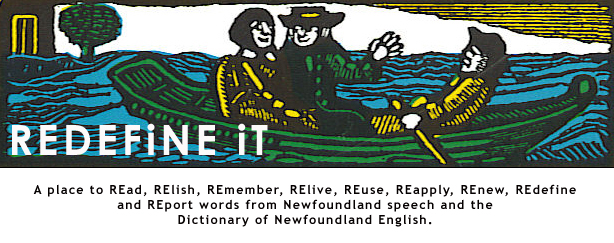The following excerpt is from the Introduction to the Dictionary of Newfoundland English:
The earliest fishermen to live year-round, establish families and plant varieties of English permanently in Newfoundland settled along the east coast in the vicinity of St John's, the Southern Shore of the Avalon Peninsula as far as Trepassey, and in the coves and harbours of Conception Bay. English thus began its development here in the very early seventeenth century at about the time of the planting of the language in Virginia and New England in the American colonies. These early settlers were brought out by chartered companies administered from Bristol and London, and the evidence points to most of them coming, like the great numbers of transient fishermen, from the coastal ports and inland villages and hamlets of the English West Country: Devon, Dorset, Somerset, Hampshire and Wiltshire.6 While the official plantations collapsed around the middle of the century, some of the settlers remained, and their variety of speech was reinforced annually by the thousands of West Country migratory fishermen whose seasonal voyages to the Island had long preceded the era of permanent settlement and continued down to the early nineteenth century. The English speech planted here, therefore, was the town and rural speech of the western counties of England, and varieties of cultivated speech current in England in the seventeenth century.
The second important linguistic strain in Newfoundland speech began in the late seventeenth century with the male English- and Irish-speaking helpers or 'servants' annually carried from southeastern Ireland, mainly through the port of Waterford, at the same time as the English adventurers obtained staple foods there for the fishing season in Newfoundland. Merchants from Ireland also sent trading ships to Newfoundland.7 The numbers of Irish servants and later of immigrants increased enormously in the late eighteenth and early nineteenth centuries so that in some years the proportions of English to Irish in Newfoundland were about even. The mixed population at the end of the eighteenth century is well depicted by Aaron Thomas:8
As this Island has been inhabit'd for such a number of years and was peopled by British and Irish, you frequently meet with Familys whose Grandfathers were born in Newfoundland. These are what I call the Natives. They speak English but they have a manner perculiar to themselves
---the common people Lisp... for [in] every Out-harbour I viseted on conversing with the people, they would on answering my enquirys say---Yes, dat is the way' or 'O No, we tant do it so; but den we do it the other way, tafter we bring it home because it is taffer.'
There are occasional documentary references to monolingual and bilingual Irishspeaking fishermen working and settling in the island in the early years, but Irish seems never to have been established in Newfoundland and has had little influence on Newfoundland English independent of the development of Anglo-Irish in parts of Ireland itself.9
To read the rest of the Introduction to the Dictionary of Newfoundland English click here.
The Dictionary of Newfoundland English can be purchased online directly from the publisher (University of Toronto Press).
Dictionary of Newfoundland English: Second Edition with supplement Edited by G.M. Story, W.J. Kirwin, and J.D.A. Widdowson
University of Toronto Press © 1998
847pp /1 map, 3 figures
Subscribe to:
Post Comments (Atom)





No comments:
Post a Comment